|
Comanche Chief Quanah Parker
Quanah Parker (c. late 1840s - February 23, 1911) was a Native American
Indian leader, the son of Comanche Chief Peta Nocona and European American woman Cynthia Ann Parker, and the last chief of
the Quahadi Comanche Indians.
| Quanah Parker |
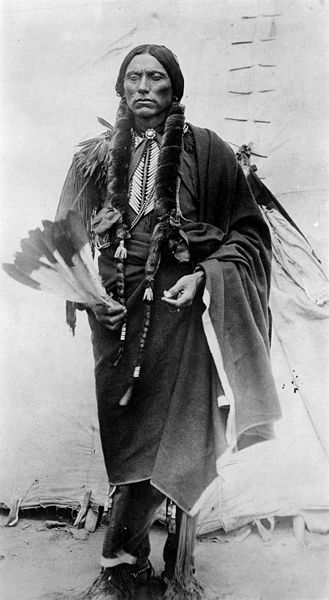
|
| National Archives |
Quanah Parker was the last Chief of the Comanches and never lost a battle
to the white man. His tribe roamed over the area where Pampas stands. He was never captured by the Army, but decided to surrender
and lead his tribe into the white man's culture, only when he saw that there was no alternative.
His was the last tribe in the Staked Plains to come into the reservation
system.
Quanah, meaning "fragrant," was born about 1850, son of Comanche Chief Peta
Nocona and Cynthia Ann Parker, a white girl taken captive during the 1836 raid on Parker's Fort, Texas. Cynthia Ann Parker
was recaptured, along with her daughter, during an 1860 raid on the Pease River in northwest Texas. She had spent 24 years
among the Comanche, however, and thus never readjusted to living with the whites again.
She died in Anderson County, Texas, in 1864 shortly after the death of her
daughter, Prairie Flower. Ironically, Cynthia Ann's son would adjust remarkably well to living among the white men. But first
he would lead a bloody war against them.
Quanah and the Quahada Comanche, of whom his father, Peta Nocona had been
chief, refused to accept the provisions of the 1867 Treaty of Medicine Lodge, which confined the southern Plains Indians to
a reservation, promising to clothe the Indians and turn them into farmers in imitation of the white settlers.
Knowing of past lies and deceptive treaties of the "White man", Quanah decided
to remain on the warpath, raiding in Texas and Mexico and out maneuvering Army Colonel Ronald S. Mackenzie and others. He
was almost killed during the attack on buffalo hunters at Adobe Walls in the Texas Panhandle in 1874. The U.S. Army was relentless
in its Red River campaign of 1874-75. Quanah's allies, the Quahada were weary and starving.
| Quanah Parker |
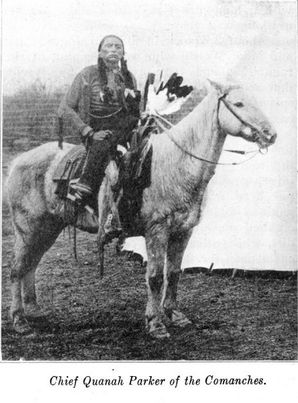
|
| Comanche Chief Quanah Parker and horse |
| Cynthia Ann Parker and daughter |
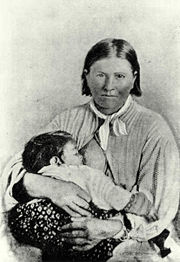
|
| Cynthia Ann Parker and daughter |
(Left) Cynthia Ann Parker and her daughter, Toh-Tsee-Ah, in 1861.
Mackenzie sent Jacob J. Sturm, a physician and post interpreter, to solicit
the Quahada's surrender. Sturm found Quanah, whom he called "a young man of much influence with his people," and pleaded his
case. Quanah rode to a mesa, where he saw a wolf come toward him, howl and trot away to the northeast. Overhead, an eagle
"glided lazily and then whipped his wings in the direction of Fort Sill," in the words of Jacob Sturm. This was a sign, Quanah
thought, and on June 2, 1875, he and his band surrendered at Fort Sill in present-day Oklahoma.
Biographer Bill Neeley writes:
"Not only did Quanah pass within the span of a single
lifetime from a Stone Age warrior to a statesman in the age of the Industrial Revolution, but he accepted the challenge and
responsibility of leading the whole Comanche tribe on the difficult road toward their new existence."
Quanah was traveling the "white man's road," but he did it his way. He refused
to give up polygamy, much to the reservation agents' chagrin. Reservation agents being political appointees of the Federal
Government, their main concern was to destroy all vestiges of Native American life and replace their culture with that of
theirs. Quanah Parker also used peyote, negotiated grazing rights with Texas cattlemen, and invested in a railroad. He learned
English, became a reservation judge, lobbied Congress and pleaded the cause of the Comanche Nation. Among his friends were
cattleman Charles Goodnight and President Theodore Roosevelt. He considered himself a man who tried to do right both to the
people of his tribe and to his "pale-faced friends".
It wasn't easy. Mackenzie appointed Quanah Parker as the chief of the Comanche
shortly after his surrender, but the older chiefs resented Parker’s youth, and his white blood in particular." And in
1892, when Quanah Parker signed the Jerome Agreement that broke up the reservation, the Comanche were split into two factions:
(1). those who realized that all that could be done had been one for their nation; and (2). those who blamed Chief Parker
for selling their country."
Quanah Parker died on February 23, 1911, and was buried next to his mother,
whose body he had reinterred at Ft. Sill Military cemetery on Chiefs Knoll in Oklahoma only three months earlier. For his
courage, integrity and tremendous insight, Quanah Parker’s life tells the story of one of America's greatest leaders
and a true Texas Hero.
| Quanah Parker History |
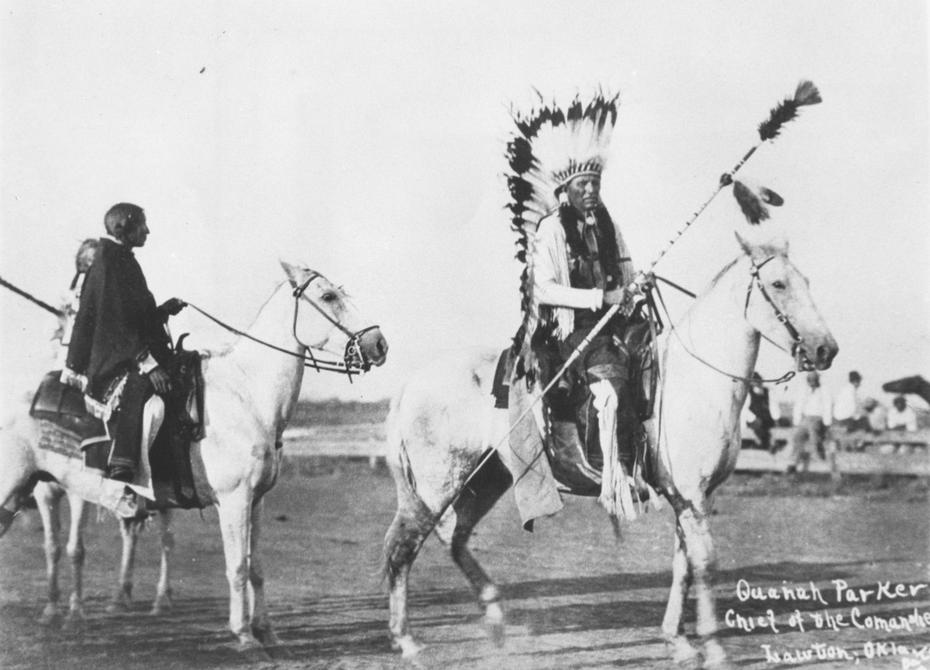
|
| Chief Quanah Parker |
| Cheif Quanah Parker, horseback |
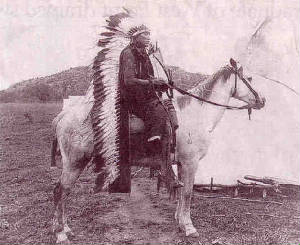
|
| Comanche Quanah Parker |
| Chief Quanah Parker |
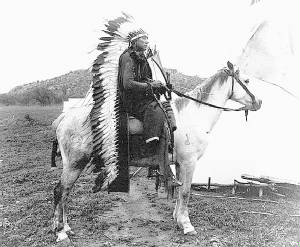
|
| Quanah Parker on horse |
(Credits listed at bottom of page.)
Highly Recommended Reading:
The Last Comanche Chief: The Life and Times of Quanah Parker, by Bill
Neeley (Hardcover). Review: Quanah Parker (1850-1911) was among the last of the free-ranging Comanche warriors who once terrorized
the high plains. Parker ascended to the rank of war chief through brave acts in almost constant warfare (Comanche is a Ute
word that means "wants to fight me all the time") with Anglos and other Indian nations alike. But Parker was more than a warrior,
Neeley observes. A great political leader, he negotiated a peace treaty with the United States that spared his people the indignities heaped on other nations that
fought back. Continued below…
Parker and others among
Neeley's cast of characters will be familiar to fans of Larry McMurtry's Lonesome Dove. Among them are such important figures
as legendary rancher Charles Goodnight and Texas Ranger Sul Ross, once Parker's enemies, later his good friends. Description: Born in 1850, Quanah
Parker belonged to the last generation of Comanches to follow the traditional nomadic life of their ancestors. After the Civil
War, the trickle of white settlers encroaching on tribal land in northern Texas suddenly turned into a tidal wave. Within a few
short years, the great buffalo herds, a source of food and clothing for the Indians from time immemorial, had been hunted
to the verge of extinction in an orgy of greed and destruction. The Indians' cherished way of life was being stolen from them.
Quanah Parker was the fiercest and bravest of the Comanches who fought desperately to preserve their culture. He led his warriors
on daring and bloody raids against the white settlers and hunters. He resisted to the last, heading a band of Comanches, the
Quahadas, after the majority of the tribe had acquiesced to resettlement on a reservation. But even the Comanches—legendary
horsemen of the Plains who had held off Spanish and Mexican expansion for two centuries—could not turn back the massive
influx of people and weaponry from the East. Faced with the
bitter choice between extermination or compromise, Quanah stepped off the warpath and sat down at the bargaining table. With
remarkable skill, the Comanche warrior adapted to the new challenges he faced, learning English and the art of diplomacy.
Working to bridge two very different worlds, he fought endlessly to gain a better deal for his people. As the tribe's elder
statesman, Quanah lobbied Congress in Washington, D.C., entertained
President Teddy Roosevelt and other dignitaries at his home, invested in the railroad, and enjoyed the honor of having a Texas town named after him. The Last Comanche Chief is a moving portrayal
of this famed leader. His story is an inspiring and compelling chapter in the history of Native Americans and of the American
West. "Truly distinguished. Neeley re-creates the character
and achievements of this most significant of all Comanche leaders." —Robert M. Utley, author of The Lance and the Shield:
The Life and Times of Sitting Bull. "An important and probably
definitive account of this tremendously significant figure in American history."—The Dallas Morning News. From the Author: I am pleased that Indians and non-Indians respect my book. Truth is
often elusive, but I did my best to discover what really happened on the Southwestern frontier in the bloody battle for possession
of the land. I hope that my readers will see that I have tried to be honest. With the passage of time, we cannot judge what
people did a hundred years ago on the basis of our current values. All we can do is find out what people did, why they did
it, and what the consequences were for those actions. Hopefully we will not make the same mistakes that our ancestors did.
I hope my readers enjoy "history with the hide on." About the Author: Bill Neeley is recognized as the preeminent authority on Quanah Parker. Featured
prominently in the segment on the great Comanche chief in the A&E television series The Real West, he is also the author
of Quanah Parker and His People. Mr. Neeley lives in Lawton, Oklahoma.
Related Reading:
Recommended Reading: Empire of the Summer Moon:
Quanah Parker and the Rise and Fall of the Comanches, the Most Powerful Indian Tribe in American History. Description:
In the tradition of Bury My Heart at Wounded Knee, a stunningly vivid historical account of the forty-year battle between
Comanche Indians and white settlers for control of the American West, centering on Quanah, the greatest Comanche chief of
them all. S. C. Gwynne’s Empire of the Summer Moon spans two astonishing stories. The first traces the rise and fall
of the Comanches, the most powerful Indian tribe in American history. The second entails one of the most remarkable narratives
ever to come out of the Old West: the epic saga of the pioneer woman Cynthia Ann Parker and her mixed-blood son Quanah, who
became the last and greatest chief of the Comanches. Continued below…
Although readers may be more familiar with the tribal names Apache and Sioux,
it was in fact the legendary fighting ability of the Comanches that determined just how and when the American West opened
up. Comanche boys became adept bareback riders by age six; full Comanche braves were considered the best horsemen who ever
rode. They were so masterful at war and so skillful with their arrows and lances that they stopped the northern drive of colonial
Spain from Mexico and halted the French expansion westward from Louisiana. White settlers arriving in Texas from the eastern
United States were surprised to find the frontier being rolled backward by Comanches incensed by the invasion of their tribal
lands. So effective were the Comanches that they forced the creation of the Texas Rangers and account for the advent of the
new weapon specifically designed to fight them: the six-gun. The war with
the Comanches lasted four decades, in effect holding up the development of the new American nation. Gwynne’s exhilarating
account delivers a sweeping narrative that encompasses Spanish colonialism, the Civil War, the destruction of the buffalo
herds, and the arrival of the railroads—a historical feast for anyone interested in how the United States came into
being. Against this backdrop Gwynne presents the compelling drama of Cynthia
Ann Parker, a lovely nine-year-old girl with cornflower-blue eyes who was kidnapped by Comanches from the far Texas frontier
in 1836. She grew to love her captors and became infamous as the "White Squaw" who refused to return until her tragic capture
by Texas Rangers in 1860. More famous still was her son Quanah, a warrior who was never defeated and whose guerrilla wars
in the Texas Panhandle made him a legend. S. C. Gwynne’s account
of these events is meticulously researched, intellectually provocative, and, above all, thrillingly told. Empire of the Summer
Moon announces him as a major new writer of American history. About the
Author: Sam Gwynne is an award-winning journalist whose work has appeared extensively in Time, for which he worked as bureau
chief, national correspondent and senior editor from 1988 to 2000, and in Texas Monthly, where he was executive editor. His
work has also appeared in the New York Times, Harper’s, and California Magazine. His previous book Outlaw Bank (co-authored
with Jonathan Beaty) detailed the rise and fall of the corrupt global bank BCCI. He attended Princeton and Johns Hopkins
and lives in Austin, Texas with his wife Katie and daughter Maisie.
Recommended Reading: Quanah
Parker, Comanche Chief (Oklahoma Western
Biographies). Description: In this book, author William T. Hagan presents the meticulously researched story of Quanah's life
and the politics of both the white and native worlds which he straddled, serving as an eloquent bridge between two societies
struggling for survival on the Oklahoma and Texas
plains. An astute businessman, Quanah recognized the futility of staving off white settlement and turned his warrior energies
toward negotiating for the best "deals" he could get for the American Indians. Continued below…
Although he made many trips to
Washington, DC, and the White House to represent the needs of the Indians and often wore western Anglo dress, he refused to
give up his braids, his "much married condition" (7 wives), and his dedication to the peyote cult. This is a fascinating book
which I highly recommend to any aficionado of the Old West and Native America.
Recommended Reading:
Comanches: The History of a People. Description: Authoritative and immediate,
this is the classic account of the most powerful of the American Indian tribes. T.R. Fehrenbach traces the Comanches’
rise to power, from their prehistoric origins to their domination of the high plains for more than a century until their demise
in the face of Anglo-American expansion. Continued below…
Master horseback riders who lived
in teepees and hunted bison, the Comanches were stunning orators, disciplined warriors, and the finest makers of arrows. They
lived by a strict legal code and worshipped within a cosmology of magic. As he portrays the Comanche lifestyle, Fehrenbach
re-creates their doomed battle against European encroachment. While they destroyed the Spanish dream of colonizing North America and blocked
the French advance into the Southwest, the Comanches ultimately fell before the Texas Rangers and the U.S. Army in the great
raids and battles of the mid-nineteenth century. This is a classic American story, vividly and poignantly told. From the Back
Cover: “For a complete history of the Comanches, this book probably has no equal.” –Dee Brown, author of
Bury My Heart at Wounded Knee. “This is a very good book. Like virtually all good books
about the American Indian, it tells a tragic story, but unlike many of them, it tells it well. The author has mastered an
extensive and complex subject: he is flexible, well-organized, and sensitive.” –Larry McMurtry. “Fehrenbach
is a highly interpretive and original writer, whose work rests on solid scholarship. His book ranges grandly across the disciplines
from folklore to anthropology to history.” –Southwestern Historical Quarterly. About the Author: T.R. Fehrenbach
was born in San Benito, Texas in 1925 and graduated from Princeton University
in 1947. He has been a contributor to many publications, including Esquire, The Atlantic, The Saturday Evening Post, and The
New Republic. He is the author of the best-selling Lone Star: A History of Texas and the Texans and Fire and Blood: A History
of Mexico, among other works. He lives in San Antonio, Texas,
with his wife, Lillian.
Recommended
Reading:
The Captured: A True Story of Abduction by Indians on the Texas
Frontier. From Booklist: On New Year's Day, 1870, Adolph Korn, the author's ancestor and son of German immigrants,
was captured by three Apaches near his family's cabin in central Texas. Adolph was traded to a band of Quahada Comanches,
with whom he lived until November 1872, when the Comanches traded their captives for those held by the U.S. Army. Adolph was
irrevocably changed. Continued below…
Considering himself Indian, he
lived in a cave, and died alone in 1900. The author's search into Korn's sad life led him to the similar stories of eight
other children captured in Texas between 1865 and 1871. Drawing on his tenacious research and interviews with the captives'
descendants, Zesch compiles a gripping account of the lives of these children as they lived and traveled with their Indian
captors. He delves into the reasons for their "Indianization," which for most of them lasted the rest of their lives, and
discusses why they couldn't adjust to white society. A fascinating, meticulously documented chronicle of the often-painful
confrontations between whites and Indians during the final years of Indian Territory. Deborah
Donovan. Copyright © American Library Association. All rights reserved
Recommended Reading:
Captured By The Indians: 15 Firsthand Accounts, 1750-1870. Description:
This is a short collection of some of the most famous Indian captivity narratives written during the late 18th and 19th centuries
when warfare raged between white settlers and the native Indian inhabitants of North America.
These narratives are not only interesting and entertaining as drama, but are invaluable to historians and ethnographers as
they provide some of the best first-hand accounts of life among the native tribes of the United States at a time when they were being wiped out by white expansion. Continued
below…
These narratives show what life
was like as an Indian, including all the blood and horror as well as all the genuine kindness and devotion inherent in any
human society. You will note that many captivity accounts were in many ways positive experiences for the captives who were
adopted into a tribe and treated with the love and respect that they would accord any of their own people. Such is the case
with men like James Smith who spent five years living with the Ohio Indians along Lake Erie. These tales were popular in their own time for providing an entertaining escape
for people who were both fearful yet fascinated by the Indians and their "savage" ways. From these accounts we learn much
about Indian lifeways, food, culture, and religion. We also learn of the cruel barbarities that the Indians could inflict
on their enemies, as we see in the tale of Dr. John Knight who witnessed the horrific torture and death of Col. William Crawford
in 1782, or the daring escape of John Slover, who had spent many years among the Shawnee, and Wyandot as a captive and who
later escaped and returned to wage war against his former captors, only to be retaken after the Battle of Sandusky. A slow
and terrible death awaited any escaped captive who fell back into Indian hands. But what is really interesting is the number
of captives who spent many years living, happily in many cases, with the Indians, showing that they were not the totally savage
heathens portrayed in many books and movies, but a society of human beings who could love and hate as equally as any other.
This is a valuable introduction to a fascinating genre of literature and is an
important part of history that should not be overlooked.
Recommended Reading:
The Comanche Empire (The Lamar Series in Western History). From
Booklist: This comprehensive history of the Comanche people treats them as an independent power rather than as victims of
American westward expansion. And though Hamalainen frames his arguments within scholars’ debates on proper perspectives
toward the Comanche, general readers interested in the history of the Southwest will discover his to be a fascinatingly informative
volume in its explanatory and narrative modes. Continued below…
Between the Comanche’s initial
appearance in Spanish records in 1706 to their final defeat by the U.S. in 1874, Hamalainen traces an ascent in Comanche numbers, wealth,
and influence that enabled them to dominate western Texas and New Mexico for decades. Interpreting such Comanche activities as raiding and slaving as
distinct instruments of imperialism, Hamalainen credits these practices with endowing the Comanche with their fierce frontier
reputation within the extensive Great Plains trading network they operated. A valuable library
resource for its subject. --Gilbert Taylor
Credits: lnstar.com; National Archives; Jo Ann Powell Exley, Frontier Blood:
the Saga of the Parker Family, Texas A & M University, 2001; S. C. Gwynne, Empire of the Summer Moon: Quanah Parker and
the Rise and Fall of the Comanches, the Most Powerful Indian Tribe in American History, New York: Scribner, 2010; William
T. Hagan, United States-Comanche Relations: The Reservation Years, New Haven, CT: Yale University Press, 1976; William T.
Hagan, Quanah Parker, Comanche Chief, Norman: University of Oklahoma Press, 1993; Clyde L. and Grace Jackson, Quanah Parker;
Bill Neeley, The Last Comanche Chief: The Life and Times of Quanah Parker, New York: John Wiley and Sons, 1995.
|

